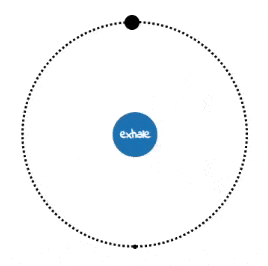Slow Breathing
Episode #6 of the course Breathwork: Science and practice by David Urbansky
Welcome back! Finally, after learning all the theory you are now getting to the practical breathwork exercises. We’ll focus on a super simple exercise with lots of proven health benefits. First I’ll explain why it works and then I’ll show you how it’s done. Ready, breathe, go!
Your breath, heart, and brain are connected. The heart follows the breath and the brain follows the heart. Slow breathing exercises lead to heart coherence, which has shown psychological benefits, such as improving vigor-activity and reducing anxiety, depression, anger, and confusion [5, 6]. It can also lead to physiological improvements, such as lowered heart rate and blood pressure [10] and reduced insomnia [11]. Why does something as simple as slow, conscious breathing have so many positive benefits, you ask?
Why Slow Breathing Works
Unlike a clock, your heart is not beating in a constant tempo, even when relaxed. There are lots of minor fluctuations. This phenomenon is called heart rate variability (HRV in short) and is a sign of health [8].
This variance is due to two influencers: your sympathetic and parasympathetic nervous systems. One increases and one decreases the speed of your heartbeat and this happens constantly. The sympathetic nervous system is your “fight or flight” system, it activates during stress and makes your heart beat faster (ready for the fight). Your parasympathetic nervous system is doing the exact opposite—it activates when you are calm, safe, and relaxed and slows down your heartbeat. When you inhale, heart rate goes up, during exhale heart rate goes down (this is called respiratory sinus arrhythmia or RSA).
Thoughts and emotions can therefore affect HRV (when you get angry your heart beats faster, when you have positive and relaxing thoughts it slows down). Have a look at the figure below showing how your heart reacts to two different emotions [12]:
You can see that the positive emotion of appreciation produces a much smoother wave—this state is called heart coherence and means that the variance in heart rate is more constant. Isn’t it amazing how the connection between breath, heart, and brain can be visualized like that?
A number of important physiological changes occur during coherence. The two branches of the autonomic nervous system synchronize with one another, and there is an overall shift in autonomic balance toward increased parasympathetic activity. There is also increased physiological entrainment—a number of different bodily systems synchronize to the rhythm generated by the heart. Finally, there is increased synchronization between the activities of the heart and brain that leads to harmony, greater emotional stability, and improved cognitive function [7, 12].
Now that we know what we’re trying to achieve, how do we get into this magic state? Heart coherence is a natural state that is affected by emotions, age, stress, and health, but it can be induced by slow breathing!
Slow breathing increases HRV [1, 2, 3, 4] by stimulating the parasympathetic nervous system [4, 13]. Remember, the parasympathetic system is your calm and relaxed system. When breathing slowly, your body understands that there is no sabertooth tiger out to get you, so it increases the parasympathetic activity which further relaxes you.
It is worth underlining that HRV modulation is highly dependent on respiration frequency, increasing along with the slowing of breath [3]. The effect is greatest during slow breathing at around six breaths per minute with equal inhale and exhale times [5, 9, 13, 14, 15, 16].
Exercise: Heart Coherence Breathing
Finally! Now that you know why slow breathing is so healthy, let’s get to how you do it. You’ll be pleasantly surprised to learn that this is super easy. As explained earlier, we want to aim for the maximum effect which occurs at six breaths per minute. That means we breathe in for five seconds, breathe out for five seconds, and repeat. One cycle is therefore ten seconds, which is six breaths per minute. According to some studies, the perfect number is 5.5 meaning 5.5 seconds in, 5.5 seconds out, but that makes counting a bit harder so we stick to 5 [14].
I have created the following animation to help you along. Start inhaling when the little black dot is at the top and start exhaling when it is at the bottom. This animation loops so you can do this as long as you like. Try it for five minutes to really get a hang of it.
Congratulations, you have just learned one scientifically proven, powerful breathing technique for your health toolbox, no prescription required!
Try the exercise now. Tomorrow we’ll go fast!
Recommended book
The Art of Breathing: The Secret to Living Mindfully by Danny Penman
References
[1] A single-participants investigation of the effects of various biofeedback-assisted breathing patterns on heart rate variability: a practitioner’s approach
[2] Effects of paced respiration on heart period and heart period variability
[3] Heart rate variability biofeedback increases baroreflex gain and peak expiratory flow
[4] Respiratory sinus arrhythmia as an index of parasympathetic cardiac control during the cardiac defense response
[5] Appearance of high-frequency alpha band with disappearance of low-frequency alpha band in EEG is produced during voluntary abdominal breathing in an eyes-closed condition
[6] Activation of the anterior prefrontal cortex and serotonergic system is associated with improvements in mood and EEG changes induced by Zen meditation practice in novices
[7] How Breath-Control Can Change Your Life: A Systematic Review on Psycho-Physiological Correlates of Slow Breathing
[8] Cardiac coherence, self-regulation, autonomic stability, and psychosocial well-being
[9] Central regulation of heart rate and the appearance of respiratory sinus arrhythmia: new insights from mathematical modeling
[10] Meta-Analysis of Effects of Voluntary Slow Breathing Exercises for Control of Heart Rate and Blood Pressure in Patients With Cardiovascular Diseases
[11] Self-Regulation of Breathing as an Adjunctive Treatment of Insomnia
[12] Cardiac coherence, self-regulation, autonomic stability, and psychosocial well-being
[13] The physiological effects of slow breathing in the healthy human
[14] Breathing at a rate of 5.5 breaths per minute with equal inhalation-to-exhalation ratio increases heart rate variability
[15] Important influence of respiration on human R-R interval power spectra is largely ignored
[16] Respiratory sinus arrhythmia in humans: how breathing pattern modulates heart rate
Share with friends




